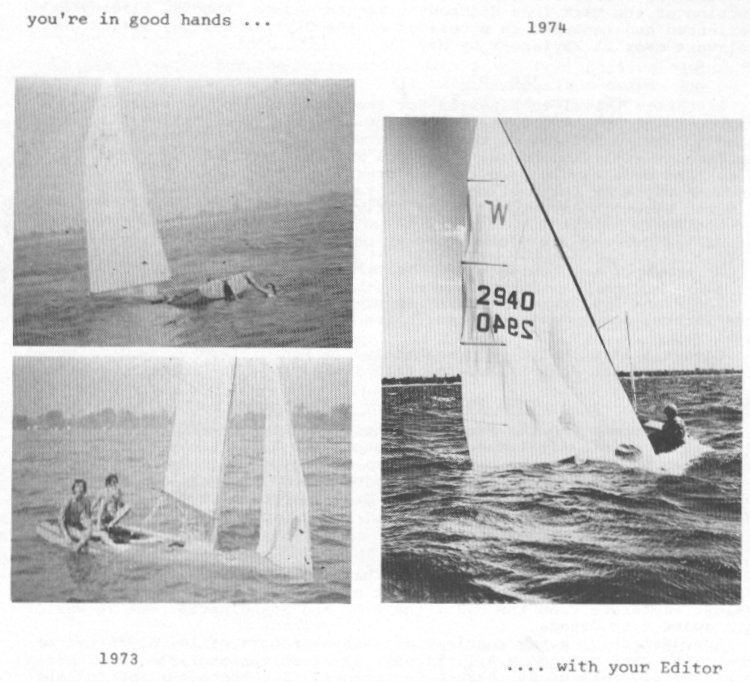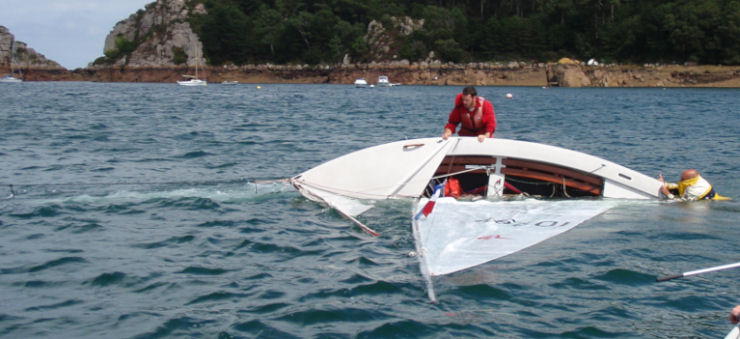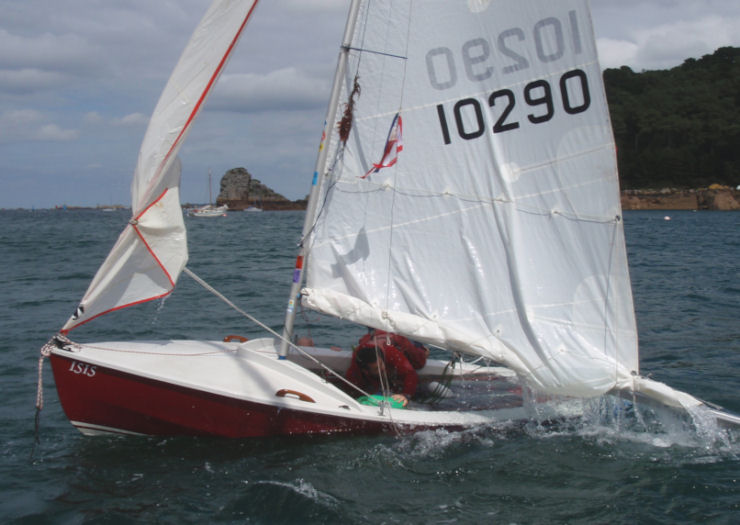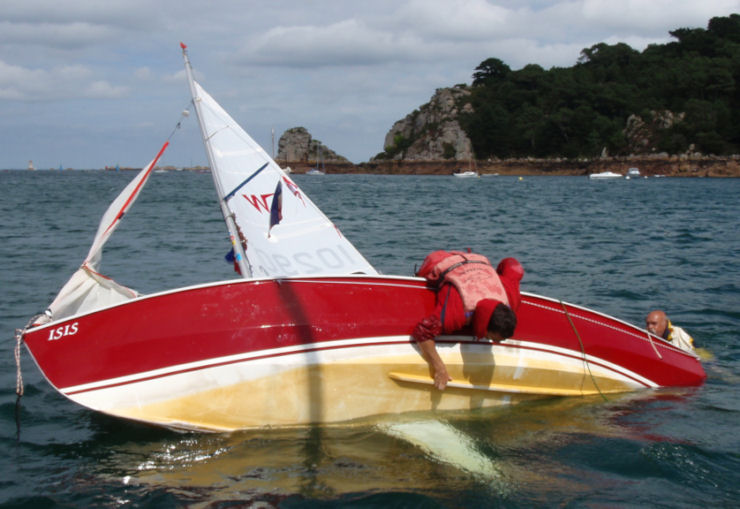The Voice of Experience
Speaks
on the
Topic of
Self-Rescue
After a Capsize
by Uncle Al
Your Uncle Al has capsized
often
enough to
qualify as an expert in self-rescue. In fact, my wife,
Julia, and I
hold
a record that is unlikely to ever be broken: We
‘dumped’ in every one
of
the dozen or so events on the 1978 North American
Wayfarer calendar!
Prepare
for
the Worst!
Before we even start to talk
of
self-rescue,
it is essential to talk about the preparations that
every Wayfarer
owner
- racers and non-racers alike - must make!
Specifically, we owe it to
ourselves
and to those who might have to rescue us, to make
certain that our
Wayfarer
complies with Class Rule 34
- Buoyancy.
And you can still get into
trouble,
even
with perfect buoyancy, if you don't have your hatches
properly battened
down (below left, W852 in the 1973 North Americans
where a
lunch-time
beaching had left Al's centreboard stuck in the up
position and Al
capsized
the boat in a fit of rage and in a last-ditch
ill-advised attempt at
freeing
the board from below - of course the front hatch was
off since it was
such
a nice, not very windy day!), or make the
mistake of taking the
hatch
cover off to see why your bow is so low in the water
after the capsize
(below right, Uncle Al the 1974 North Americans!)
 Needless to say, a proper PFD -
worn or
easily accessible - for each individual
aboard, and clothing appropriate to wind and water
temperature plus a
functional bailing bucket (tied to the boat!!!) are also
absolutely
essential.
Needless to say, a proper PFD -
worn or
easily accessible - for each individual
aboard, and clothing appropriate to wind and water
temperature plus a
functional bailing bucket (tied to the boat!!!) are also
absolutely
essential.
When
the
worst happens
Many of us live in fear of
capsizing on
a
windy day. One of the best ways to remove some of that
fear is to do
some
practice capsizes in a nice, controlled environment.
When I was a
Junior
Sailing instructor, we found that capsize practice was
one of the kids'
favourite activities, and of course, they soon lost
any fear of
capsizing
that they might have had.
But let us assume that you
have had no
capsize
experience. What is the worst that can happen?
Probably, it's a death
roll
where the boat capsizes to windward on a run and
immediately "turtles"
(inverts, goes mast down). With the mainsail all the
way out, sail and
mast can knife through the water very quickly, and in
theory, the hull
can come over right on top of you. I for one, was very
scared of such a
thing happening to me and of getting trapped under the
hull. But it has
been my experience (alas, too frequent!) that you
still end up beside
the
hull not under it, even after a death roll. Moreover,
the famous UK
cruiser,
Ralph Roberts, assures me that there is no problem
even if you do end
up
under the hull. There is lots of space between the
surface of the water
and the floor of the boat. In fact, Ralph pointed out
that in really
vicious
sea conditions, he has deliberately sought a bit of
shelter from the
waves
by going under the hull.
So we'll assume you have just
done a
death
roll and are now floating beside your turtled
Wayfarer. The good news
is,
that all the wild excitement tinged with fear is now
over. You can
relax
- unless, God forbid, your are sailing in
shark-infested waters. Check
that your partner is also OK, and think what a good
story this
adventure
will make. A bit of humour is always good - especially
if your crew
tends
to get a bit nervous.
I still remember one of my
first
death rolls.
We had driven most of the night to get to our Spring
Regatta on the
Chesapeake
Bay but awoke to the news that racing would be
cancelled for the
Saturday
due to small craft warnings for the Bay. Well, after
driving all that
way,
my crew and I decided to take W852 out for a little
run anyway.
Fortunately
both wind and water were warm for early May as we beat
north into
12-foot
waves. After a couple of miles, we decided we had
earned the right to a
nice ride downwind, and bore off to broad reach back
down to the
Podickory
Point YC. The first wave we caught seemed to carry us
forever on an
exhilarating
wild plane but as we started down the second wave, our
nicely balanced
helm became a non-existent helm. I looked back just in
time to see our
rudder blade porpoising about 30 feet astern. By this
time the boat had
borne away radically and the next thing I recall I was
floating beside
a turtled W852 with my crew, Freddie. There was not
another boat in
sight
anywhere, and the Bay looked awfully big as we climbed
onto the hull.
"Freddie!"
I said to my crew, "You missed a couple of spots here
when you cleaned
the bottom of the boat!!!" That gave us both something
to smile at and
then we sat for a while and planned our course of
action before we went
about the job of trying to rescue ourselves. We were
certainly glad we
had the prescribed bailing bucket, but without a
rudder, things were
challenging.
We ended up working our way downwind towards the PDYC
- under jib
alone,
I believe, and steering with a paddle, and someone
came out in a motor
boat to tow us the final 100 yards before the outgoing
tide could sweep
us past the harbour mouth.
Recovering
from capsize
As far as I'm aware, the
approved
procedure
taught in most sailing schools in Canada is that one
of the crew should
swim forward and hold the bow head to wind. With all
due respect, I
can't
see how that helps. In fact, the last thing I want to
be doing with a
boat
full of water is pointing straight into a 20-knot
wind. By the time
I've
stopped going backwards, I'm sure I'll capsize again -
not to mention
having
sapped my crew's strength.
In my (extensive) experience,
the
ideal position
for a boat you want to right, is sideways to the wind.
However, you do
want to make certain that you
never
right the boat with the mast and mainsail pointing
towards the wind!
I did that once in a
Fireball and of
course the wind got under the main and flipped the
entire hull and mess
of tangled ropes right over on top of me. That was the
closest I've
ever
come to panic as I struggled to get untangled before
the hull trapped
me.
Al's
note 2 Dec 09: Thanks to Chris Codling whose 2009
International Rally
pics included this series of pics that shows "what
you should not do",
as Papa Bear once said in
the Berenstain Bears' The Bike Lesson
- the very thing I've been on the look-out for:

The tow boat is not helping any by turning away from
shore and towards
the camera. A 90° turn to port will leave this mast
pointing more
or less into the wind, where the crew working to
right the boat will
likely discover that righting is easier with the
main reefed. And once
the head of the main comes clear of the water the
righting process
becomes all too easy as ...

... the stiff breeze fills the sail, whips it to the
lee side (head
down, crew!!) with a 99% chance of ...
 ... another
capsize - even with this reefed main - imagine how
much more certain a
full main would make the second capsize!! Noble
effort by the crew but
doomed to failure, I expect. The good news is that
now the mast will be
pointing downwind for the second try at re-righting. ... another
capsize - even with this reefed main - imagine how
much more certain a
full main would make the second capsize!! Noble
effort by the crew but
doomed to failure, I expect. The good news is that
now the mast will be
pointing downwind for the second try at re-righting.
In
defence of the rescue team!!
-----
Original Message -----
From:
Ralph Roberts
Sent:
Thursday, December 03, 2009 4:39 AM
Subject: capsize pics
Hi Al,
Glad you found the pics
ideal
for your guide to capsizing! Obviously they do
illustrate your points
well, and I wouldn't suggest there is any need to
amend your
statements, but in defence of the (brilliant!) French
instructors, the
situation occurred near the mouth of a tidal river in
Brittany, and the
current needed to be experienced to be believed. The
guy on the rescue
craft therefore had to hold the boat against the
current, rather than
the wind direction being any priority. As can be seen
in the photos,
the back tank is at least partially flooded (not
surprisng with the
inverted boat being pinned against a fish farm by the
flood tide for 20
to 30 mins), so the transom of the boat is beneath the
water when
righted, making it incredibly unstable. In fact, I
thought the only
chance of saving the boat would be to tow it in its
inverted state to
the shore - obviously sacrificing the mast, but at
least saving the
boat. The fact that the instructor did somehow manage
to get it to
shore in an upright position was down to his great
skill. (I didn't see
the latter stages, as I took the Dutch crew back to
our base for a hot
shower and change into dry clothes)...
Best wishes, Ralph
The good news is, however,
that a
capsized
or turtled boat most often seems to end up lying
sideways on to the
wind
direction with the mast pointing where you want it -
downwind!
In any case, recovering
from
a
"Greenlander"
(as the Danes call it when the
mast
points
down at the bottom of the sea), is a
three-stage
operation (if
your
mast is already horizontal, skip step A)
A.
to move
the mast
from vertical (pointing at the sea bed) to
horizontal
1. If
necessary
and
possible, uncleat main and jib sheets so that you
will not have to drag
your main and jib through the water like giant
paddles.
2. If
necessary
and
possible, put the centreboard into its full down
position.
3. One
crew now
stands
(as best he can!) on the windward
rubrail, grabs the tip of the board and tries to
hang his butt as far
out
to as possible in order to start the mast back to a
horizontal
position.
Depending on the situation and crew weight, it may
require both crews
hanging
off the centreboard tip to get the job done,
especially if main and jib
sheet are not freed. And of course, if your mast is
stuck in mud, you
will
most likely require outside assistance.
4. If,
for any
reason,
the centreboard cannot be used for the above
purpose, use the jib sheet
instead of the centreboard. I've done this, and it
works! Grab the jib
sheet on the leeward side, lead it over the hull
towards the windward
side
and then hang off it while standing on the windward
rubrail. And if you
can't find a jib sheet, tie any piece of line
available, around the
leeward
shroud at deck level and use it the way you would
use the jib sheet. (I
have not tried this but it makes sense, I
think/hope?)
B.
righting
the boat
from the mast horizontal position
The
standard way
to
accomplish this by having one or both crew members
stand on the
centreboard.
The further out you move from the hull, the more
leverage you will
exert.
The routine should be as follows:
1. Boat
position:
Make sure that your
mast is
pointing straight
downwind or at least no more than about 45º to
either side of
straight
downwind. This is one time when it's worth swimming
the bow around
until
the mast points in the right direction!!
2. Sail
preparation:
If necessary and possible, lower the spinnaker
(if it
was
flying),
and uncleat main and jib sheets so that you will not
have to lift a ton
of water as well as the sails.
3. Getting
the
leverage: Put the centreboard into its full
down position.
4. Using
the
leverage: One crew now stands on the
centreboard, grabs the edge
of the
deck
and tries to hang his butt as far out to as possible
in order to start
the mast back to a vertical position. Depending on
the situation and
crew
weight, it may require both crews on the centreboard
to get the job
done,
especially if main and jib sheet are not completely
freed. Except under
exceptional circumstances - which I cannot at this
time imagine - do
not lower any of your sails except a
spinnaker
that may have been up. The main and jib have an
excellent dampening
effect
on the speed of bringing the boat back upright at a
reasonable speed
and
even more importantly, they make the boat far less
prone to
inverting/turtling/doing
a Greenlander! And besides, you'll need those sails
to complete your
self-rescue!!!
5. Getting
one
person
back into the boat: With practice, you will be
able to judge the
moment
of no return and flip yourself back into the boat as
she rights -
rather
than waiting for the mast to get totally vertical
and then trying to
climb
back into the boat (which is not always easy -
especially if you're
wearing
bulky clothes and PFD). Only one person should do
this. The other
should
hang onto the hull and relax for a moment.
An
impressive
method
that I've seen a 5-0-5 use, is having the heavier
person stand on the
lowered
board while the lighter person remains "inside" the
cockpit. The boat
is
then righted with one person already in it and ready
to do the
necessary
to keep the boat under control and not let it
capsize again.
C.
Completing the
Recovery
1. Uncle
Al's Special Trick!!! The very first
thing
you should do after getting one person back into the
boat, is to fully
raise the centreboard.
Wayfarer
Man and
I
learned this the hard way in the '92 Worlds at
Hayling Island. In
(warm!)
winds of Force 6-7, we were one of 28 of 52 boats to
dump. Having
thoroughly
washed MOJO (kindly lent to us by Phil
Warner!), we righted her
with no problem in the two-metre chop, but the first
gust put her over
once more as she "tripped" over the fully lowered
centreboard. We
re-righted MOJO
a second time, let the sails totally luff and this
time, raised the
board
completely.
With the
board
up, no
forward
momentum, and sails
totally luffing, the
boat will stabilize
sideways
on to the wind, even when filled with water - i.e.
you don't need to
touch
the tiller, and heel is no particular problem!!! You
can just sit and
relax,
so I've taken to calling this R & R mode (Rest
& Relaxation).
2. Retrieving
the
crew:
The beauty of going into the R & R mode (board
up, no forward momentum, and sails totally luffing)
is that you are now free to concentrate on
essentials such as helping
your
crew get back into the boat. You can help him or her
a lot by simply
heeling
the boat to windward (until the windward gunwale is
under water, if
necessary!!)
to enable your crew to crawl/slide over the gunwale
and back into the
boat.
While such heeling would be suicide if you had any
forward momentum, it
is perfectly safe when the boat is dead in the water
- if you'll pardon
the expression!
3. Clean-Up:
Now that you are both safely back aboard, is a good
time to do a bit of
cleaning up. For starters, grab any gear that is in
danger of floating
away such as paddles, floor boards or half empty
cognac bottles, and
store
them as best you can - if all else fails, one of you
can hold onto
these
while
the other bails!
4. Bailing:
Of
course, your bailing bucket was tied to the boat,
right? We (often) tie
ours to a halyard. Another of the bonuses of the R
& R mode is that
the fully raised centreboard keeps the water from
gushing into the boat
through the centreboard box faster than you can
bail. You'll still take
water over the side occasionally but we found that
even in the nasty
Hayling
chop, we were fairly easily able to bail MOJO
to the point
where
the water was barely above the floorboards and we
could sail again. You
may as well close your automatic bailers, before you
start using the
bucket.
The R & R mode is also good for letting you take
the time to remove
in relative calm, any ropes that have partially
escaped through the
bailers.
Closing the bailers will also make sure that no
ropes get stuck in them
- something that always seems to happen if you leave
the bailers open
after
you capsize.
5. Getting
underway
once
more: Once you have lowered the water level in
the boat to
near
the floorboard level, it is pretty safe to stop
bailing and start
sailing.
But first, remember to
- stow
any
loose gear that
may get in your way and ropes that may want to go
out through your
bailers
with the water
- grab
some
refreshment before
the real action starts again
- put
the
board
half down,
open the bailers and move your crew weight well
aft
- sail
a
reach
for best bailing
speed
Note:
I
have seen
Wayfarers capsized, righted, and sailed dry without
the benefit of
bucket
bailing - once even with the spinnaker up in a
"kuling" (30 knots +) on
Furesøen near Copenhagen. One of these days, I must
try that.
Although
I've never managed this myself, it is clear that you
must put your crew
weight as far aft as is possible. If you do it right,
I suspect you
should
be able to slop a lot of your in-boat water out the
back of the boat
over
the transom - even at speeds that would not be enough
to make your
bailers
work - provided that your weight aft has almost
submerged the transom.
The other benefit of weight aft once the boat starts
moving is that the
pointy section of the bow (which will easily deflect
your course and
overpower
your rudder when the boat is full of water and/or
going fast), will be
out of the water and you'll be sailing on the flatter,
more forgiving
aft
sections of the hull. I'd be happy to hear from anyone
who would care
to
share the experience they've gained using this method.
Best wishes for a safe and
happy
2001 from
Uncle
Al (W3854)
|



 ... another
capsize - even with this reefed main - imagine how
much more certain a
full main would make the second capsize!! Noble
effort by the crew but
doomed to failure, I expect. The good news is that
now the mast will be
pointing downwind for the second try at re-righting.
... another
capsize - even with this reefed main - imagine how
much more certain a
full main would make the second capsize!! Noble
effort by the crew but
doomed to failure, I expect. The good news is that
now the mast will be
pointing downwind for the second try at re-righting.